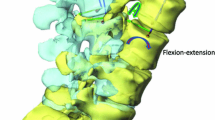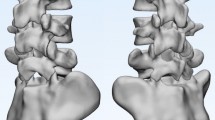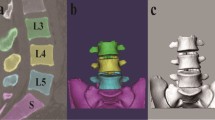Abstract
Purpose
Little is known about the coupled motions of the spine during functional dynamic motion of the body. This study investigated the in vivo characteristic motion patterns of the human lumbar spine during a dynamic axial rotation of the body. Specifically, the contribution of each motion segment to the lumbar axial rotation and the coupled bending of the vertebrae during the dynamic axial rotation of the body were analyzed.
Methods
Eight asymptomatic subjects (M/F, 7/1; age, 40–60 years) were recruited. The lumbar segment of each subject was MRI scanned for construction of 3D models of the vertebrae from L2 to S1. The lumbar spine was then imaged using a dual fluoroscopic system while the subject performed a dynamic axial rotation from maximal left to maximal right in a standing position. The 3D vertebral models and the fluoroscopic images were used to reproduce the in vivo vertebral motion. In this study, we analyzed the primary left–right axial rotation, the coupled left–right bending of each vertebral segment from L2 to S1 levels.
Results
The primary axial rotations of all segments (L2–S1) followed the direction of the body axial rotation. Contributions of each to the overall segment axial rotation were 6.7° ± 3.0° (27.9 %) for the L2–L3, 4.4° ± 1.2° (18.5 %) for the L3–L4, 6.4° ± 2.2° (26.7 %) for the L4–L5, and 6.4° ± 2.6° (27.0 %) for the L5–S1 vertebral motion segments. The upper segments of L2–L3 and L3–L4 demonstrated a coupled contralateral bending towards the opposite direction of the axial rotation, while the lower segments of L4–L5 and L5–S1 demonstrated a coupled ipsilateral bending motion towards the same direction of the axial rotation. Strong correlation between the primary axial rotation and the coupled bending was found at each vertebral level. We did not observe patterns of coupled flexion/extension rotation with the primary axial rotation.
Conclusions
This study demonstrated that a dynamic lumbar axial rotation coupling with lateral bendings is segment–dependent and can create a coordinated dynamic coupling to maintain the global dynamic balance of the body. The results could improve our understanding of the normal physiologic lumbar axial rotation and to establish guidelines for diagnosing pathological lumbar motion.





Similar content being viewed by others
References
Dvorak J, Panjabi MM, Chang DG, Theiler R, Grob D (1991) Functional radiographic diagnosis of the lumbar spine. Flexion–extension and lateral bending. Spine 16:562–571
Cholewicki J, Crisco JJ 3rd, Oxland TR, Yamamoto I, Panjabi MM (1996) Effects of posture and structure on three-dimensional coupled rotations in the lumbar spine. A biomechanical analysis. Spine 21:2421–2428
Kato Y, Panjabi MM, Nibu K (1998) Biomechanical study of lumbar spinal stability after osteoplastic laminectomy. J Spinal Disord 11:146–150
Wang JC, Arnold PM, Hermsmeyer JT, Norvell DC (2012) Do lumbar motion preserving devices reduce the risk of adjacent segment pathology compared to fusion surgery? A Systematic Review. Spine. doi:10.1097/BRS.0b013e31826cadf2
Hilibrand AS, Carlson GD, Palumbo MA, Jones PK, Bohlman HH (1999) Radiculopathy and myelopathy at segments adjacent to the site of a previous anterior cervical arthrodesis. J Bone Jt Surg Am 81:519–528
Abumi K, Panjabi MM, Kramer KM, Duranceau J, Oxland T, Crisco JJ (1990) Biomechanical evaluation of lumbar spinal stability after graded facetectomies. Spine 15:1142–1147
Mimura M, Panjabi MM, Oxland TR, Crisco JJ, Yamamoto I, Vasavada A (1994) Disc degeneration affects the multidirectional flexibility of the lumbar spine. Spine 19:1371–1380
Panjabi MM, Goel VK, Takata K (1982) Physiologic strains in the lumbar spinal ligaments. An in vitro biomechanical study 1981 Volvo Award in Biomechanics. Spine 7:192–203
Li G, Wang S, Passias P, Xia Q, Wood K (2009) Segmental in vivo vertebral motion during functional human lumbar spine activities. Eur Spine J 18:1013–1021. doi:10.1007/s00586-009-0936-6
Li W, Wang S, Xia Q, Passias P, Kozanek M, Wood K, Li G (2011) Lumbar facet joint motion in patients with degenerative disc disease at affected and adjacent levels: an in vivo biomechanical study. Spine 36:E629–E637. doi:10.1097/BRS.0b013e3181faaef7
Rousseau MA, Bradford DS, Hadi TM, Pedersen KL, Lotz JC (2006) The instant axis of rotation influences facet forces at L5/S1 during flexion/extension and lateral bending. Eur Spine J 15:299–307. doi:10.1007/s00586-005-0935-1
Sengupta DK, Demetropoulos CK, Herkowitz HN (2011) Instant axis of rotation of L4–5 motion segment—a biomechanical study on cadaver lumbar spine. J Indian Med Assoc 109:389–390, 392–383, 395
Panjabi MM, Oxland TR, Yamamoto I, Crisco JJ (1994) Mechanical behavior of the human lumbar and lumbosacral spine as shown by three-dimensional load-displacement curves. J Bone Jt Surg Am 76:413–424
Nachemson AL, Schultz AB, Berkson MH (1979) Mechanical properties of human lumbar spine motion segments. Influence of age, sex, disc level, and degeneration. Spine 4:1–8
Eysel P, Rompe J, Schoenmayr R, Zoellner J (1999) Biomechanical behaviour of a prosthetic lumbar nucleus. Acta Neurochir 141:1083–1087
El-Rich M, Shirazi-Adl A, Arjmand N (2004) Muscle activity, internal loads, and stability of the human spine in standing postures: combined model and in vivo studies. Spine 29:2633–2642
Gracovetsky S, Newman N, Pawlowsky M, Lanzo V, Davey B, Robinson L (1995) A database for estimating normal spinal motion derived from noninvasive measurements. Spine 20:1036–1046
Pearcy MJ, Tibrewal SB (1984) Axial rotation and lateral bending in the normal lumbar spine measured by three-dimensional radiography. Spine 9:582–587
Fujii R, Sakaura H, Mukai Y, Hosono N, Ishii T, Iwasaki M, Yoshikawa H, Sugamoto K (2007) Kinematics of the lumbar spine in trunk rotation: in vivo three-dimensional analysis using magnetic resonance imaging. Eur Spine J 16:1867–1874. doi:10.1007/s00586-007-0373-3
Haughton VM, Rogers B, Meyerand ME, Resnick DK (2002) Measuring the axial rotation of lumbar vertebrae in vivo with MR imaging. AJNR Am J Neuroradiol 23:1110–1116
Ochia RS, Inoue N, Renner SM, Lorenz EP, Lim TH, Andersson GB, An HS (2006) Three-dimensional in vivo measurement of lumbar spine segmental motion. Spine 31:2073–2078. doi:10.1097/01.brs.0000231435.55842.9e
Wang S, Passias P, Li G, Wood K (2008) Measurement of vertebral kinematics using noninvasive image matching method-validation and application. Spine 33:E355–E361. doi:10.1097/BRS.0b013e3181715295
Rozumalski A, Schwartz MH, Wervey R, Swanson A, Dykes DC, Novacheck T (2008) The in vivo three-dimensional motion of the human lumbar spine during gait. Gait Posture 28:378–384. doi:10.1016/j.gaitpost.2008.05.005
Karski T (2006) Recent observations in the biomechanical etiology of so-called idiopathic scoliosis. New classification of spinal deformity–I-st, II-nd and III-rd etiopathological groups. Stud Health Technol Inform 123:473–482
Lafage V, Schwab F, Patel A, Hawkinson N, Farcy JP (2009) Pelvic tilt and truncal inclination: two key radiographic parameters in the setting of adults with spinal deformity. Spine 34:E599–E606. doi:10.1097/BRS.0b013e3181aad219
Murans G, Gutierrez-Farewik EM, Saraste H (2011) Kinematic and kinetic analysis of static sitting of patients with neuropathic spine deformity. Gait Posture 34:533–538. doi:10.1016/j.gaitpost.2011.07.009
Acknowledgments
NIH R21 AR057989, Scoliosis Research Society (SRS) grant and Synthes Inc. research grant are acknowledged.
Conflict of interest
None of the authors has any potential conflict of interest.
Author information
Authors and Affiliations
Corresponding author
Additional information
J.-H. Shin and S. Wang contributed equally to this study.
Rights and permissions
About this article
Cite this article
Shin, JH., Wang, S., Yao, Q. et al. Investigation of coupled bending of the lumbar spine during dynamic axial rotation of the body. Eur Spine J 22, 2671–2677 (2013). https://doi.org/10.1007/s00586-013-2777-6
Received:
Revised:
Accepted:
Published:
Issue Date:
DOI: https://doi.org/10.1007/s00586-013-2777-6




